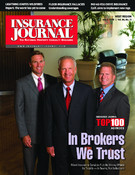Strategies From ‘Best Practices’ Agencies
Searching for ways to survive and thrive in the soft market cycle? Cultivate untapped customer markets; proactively service renewals; use technology for efficient agency management; and assertively seek referrals.
Those are tips offered by principals from three agencies recognized by the Independent Insurance Agents and Brokers as “Best Practices” agencies — firms that are the “best of the best” in their revenue categories.
Speaking as part of a panel on surviving the soft market cycle at the Independent Insurance Agents of Texas annual convention, Brad Berrong of Ed Berrong Insurance Agency said he sees opportunities in the soft market. It’s a good time to develop new insurance company relationships, as companies are looking to expand their writings. It’s a good time to move good, but perhaps slightly difficult, accounts from surplus lines into standard markets for the same reason, he said.
Berrong, whose agency handles property and casualty risks, and group and individual health accounts, said while property lines have softened considerably, casualty accounts have held their own. He said he’s not seeing the same softening in general liability that’s occurring with property accounts unless they are part of a package.
Frank Swingle of Swingle Collins & Associates said his firm concentrates on middle market commercial business and industries such as technology, real estate and manufacturing. Like Berrong, Swingle said he’s seen a real downswing in property. “If it’s a large account … we’re seeing insanity. It has nothing to do with the risk itself.”
Pierson & Fendley Insurance focuses on a “smaller market … within probably a 50-mile radius” of its office, said agency principal Matt Frierson. He said commercial property prices are down, but personal lines seem to have stabilized.
Untapped Markets
Berrong said ethnic communities are an untapped market. He said between 15 percent and 20 percent of his commercial accounts are with businesses that are owned by Asian Indians. Pakistanis and Hispanic-owned accounts are also well-represented in Berrong’s book of business.
He explained that ethnic communities are often closely-knit, and that if a service provider does a good job for them, word gets around. Also, Berrong said, Asian Indians have the highest average income level per person in the United States, twice the average income level per person as Caucasians. Chinese and Koreans also average high average per person income levels, he noted.
“That’s a very big market,” Berrong said. “If people are missing embracing the change in ownership that’s occurring in our country, then they’re missing out on a lot of these accounts,” he said.
When working with ethnic groups that are different than one’s own, it’s important to make an effort to understand and relate to them, verbally as well as culturally, he noted.
Referrals
Berrong, Frierson and Swingle agreed that referrals are essential for success, whether it’s a soft or hard market, or something in between.
Swingle said his agency aggressively seeks to solve problems for customers, including helping to prevent problems by addressing risk control issues. The company is equally aggressive in seeking referrals from the accounts for which they do a good job.
“We try to go in and solve problems for our customers, and if we solve problems for one customer … we also ask for referrals. We’re very proactive,” Swingle said.
Berrong said domination in special fields, such as the oil and gas industry, helps to generate referrals. “As an example — oil field consultants, drilling consultants, flow testers — when you have a pretty sizable percentage of that, that’s when the referrals start coming, because they’re talking to their peers. And if they’ve heard from three or four of their peers [about you] that’s where they go,” he said.
Another positive, as far as referrals go, “is we have this reputation for taking stuff that’s got ‘hair’ on it,” Berrong said. He said smaller agencies generally send customers with difficult risks to Berrong. “They don’t want to tackle them,” he said. Instead they tell their customers, “You need to go to Berrong’s, they’ll take care of you.”
Make the Most of Technology
The use of technology to manage customer expectations, keep on top of renewals and enhance customer retention is one of the cornerstones of Pierson & Fendley’s success, Frierson said. “What we really want to look at is our retention overall, even if it costs us a little bit in the soft market,” he said. “We want the customer to know, very bluntly, that we are there for them and that we want to build that loyalty with them.”
Frierson said one employee’s job as a personal lines rater is to manage the agency’s book of renewal business. Technology plays a big part in that.
“We look at the rates and we know beforehand, 60 days before renewal,” Frierson said. So, when a client calls saying he has seen an ad claiming he can save 33 percent on insurance, “we already know that. … We’ve already done our effort on the front- end and we can say, ‘look, we’ve got a carrier that can save you X amount of dollars on home and auto.’ … We’ve already beat them to the punch. That’s our own way of marketing.”
Berrong agreed “there’s a lot re-marketing going on, and if … you’re using technology well, it’s so much easier to come up with the re-marketing package. … I have never ever spent a dollar on technology where it was directed and engineered … that I haven’t at least gotten two and a half times the return in less than a year,” he said.
“Just look at how much more productive we are today than we were even five years ago,” Swingle added. “You can put an Adobe package with a whole submission together in 20 minutes on an account, where it used to take half a day to do that.”
Topics Agencies Tech Pricing Trends Property Market
Was this article valuable?
Here are more articles you may enjoy.


 High Demand for Gen AI Insurance; Buyers Say They’ll Pay More: Report
High Demand for Gen AI Insurance; Buyers Say They’ll Pay More: Report  US Tariffs on Heavy Truck Imports to Begin Nov. 1, Says Trump
US Tariffs on Heavy Truck Imports to Begin Nov. 1, Says Trump  Greystar, Other Landlords Agree to $141M Settlement in Rent-Setting Lawsuit
Greystar, Other Landlords Agree to $141M Settlement in Rent-Setting Lawsuit  Jaguar Land Rover Bailout Shows Rising Cost of Cybercrime
Jaguar Land Rover Bailout Shows Rising Cost of Cybercrime 


